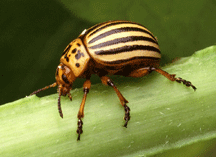
|
Volume XVII, Issue 11 - March 12 - March 18, 2009
|
|
Columns Reviews |

Grow Your Own Potatoes
But don’t start yet: St. Pat’s Day is too early
There is nothing like baking a potato freshly dug from your garden. Starting in summer, you can, because potatoes are easy to grow and abundant in harvest.
A 25- to 30-foot-long row can easily yield a bushel or two — if you follow these instructions.
First, don’t believe the old legend about having to plant potatoes on St. Patrick’s Day. Here in Southern Maryland, the soil is often too wet and soggy come March 17, so your seed-pieces will rot. Delay planting your potatoes until the soil can be easily Rototilled or plowed.
Don’t plant potato peelings and expect to get a crop. This is a sure way to experience failure. If plants do grow, they will likely produce small potatoes at best. For maximum sprouting, purchase certified seed-potatoes that have been properly stored.
Prepare your soil by tilling in a generous amount of compost prior to planting.
The day before you plant, cut the seed potatoes into pieces. Each piece should have at least one eye and preferably two. Spread the seed-pieces on a shelf in a warm room to allow the cut surfaces to callus. A sugary substance in the potato called suberin will form on the cut surface and make the seed-piece resistant to rot-causing organisms common in soils.
|
|
![]() Some recommend dusting the seed-pieces with Captan dust before planting. But over the years I have found that simply allowing the seed-pieces to callus overnight provides adequate protection.
Some recommend dusting the seed-pieces with Captan dust before planting. But over the years I have found that simply allowing the seed-pieces to callus overnight provides adequate protection.
I plant the seed pieces only a few inches deep and about a foot apart. After planting, mound three to four inches of soil over the row. The mounded soil will speed warming.
Within two to three weeks, the seed-pieces will sprout, and new foliage will appear on the surface of the mound.
Colorado potato beetles are the No. 1 enemy of potato farming. A daily walk through your potato patch will generally provide sufficient control in the beginning. Pick off the beetles and kill them in one of two ways: Either dunk them in a container with dish detergent and water or squeeze them between your fingers.
As soon as the potatoes are about 12 inches tall, mulch them with immature compost. (That’s compost in an advanced but incomplete stage of decomposition, with soggy leaves still visible.) I generally mulch my potato plants three or four times so that eventually the mulch surrounding the plants is 12 to 18 inches high. The immature compost helps to keep Colorado potato beetle away.
By mulching the potato plants with compost, you can begin harvesting potatoes in July while the plants are still producing. Simply reach into the mound of compost mulch and remove a potato. Then taste the difference.
